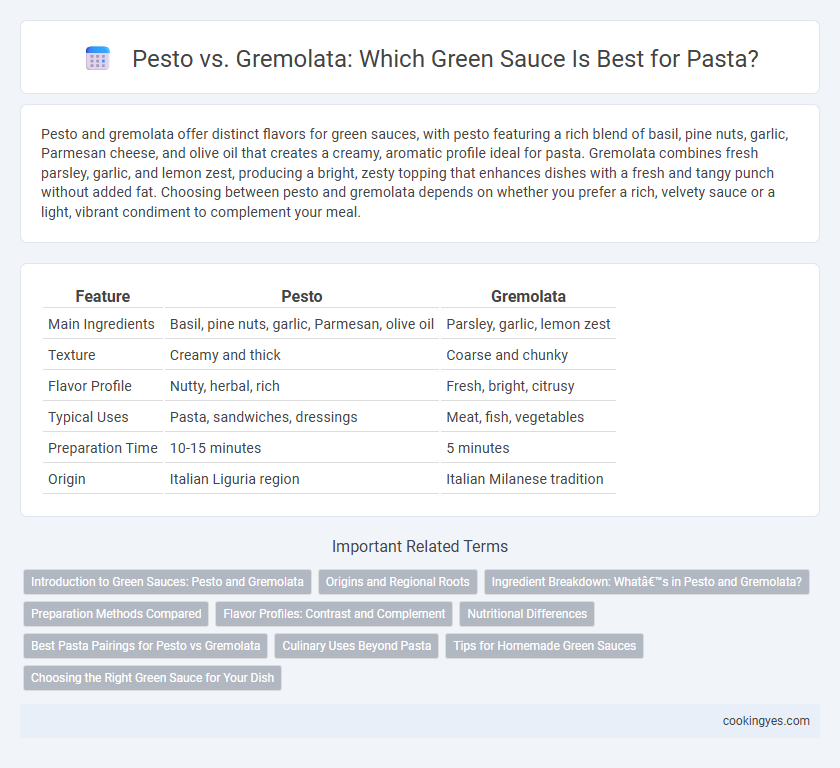Pesto and gremolata offer distinct flavors for green sauces, with pesto featuring a rich blend of basil, pine nuts, garlic, Parmesan cheese, and olive oil that creates a creamy, aromatic profile ideal for pasta. Gremolata combines fresh parsley, garlic, and lemon zest, producing a bright, zesty topping that enhances dishes with a fresh and tangy punch without added fat. Choosing between pesto and gremolata depends on whether you prefer a rich, velvety sauce or a light, vibrant condiment to complement your meal.
Table of Comparison
| Feature | Pesto | Gremolata |
|---|---|---|
| Main Ingredients | Basil, pine nuts, garlic, Parmesan, olive oil | Parsley, garlic, lemon zest |
| Texture | Creamy and thick | Coarse and chunky |
| Flavor Profile | Nutty, herbal, rich | Fresh, bright, citrusy |
| Typical Uses | Pasta, sandwiches, dressings | Meat, fish, vegetables |
| Preparation Time | 10-15 minutes | 5 minutes |
| Origin | Italian Liguria region | Italian Milanese tradition |
Introduction to Green Sauces: Pesto and Gremolata
Pesto and gremolata are two vibrant green sauces that enhance pasta dishes with fresh, herbal flavors. Pesto, originating from Liguria, Italy, traditionally combines basil, pine nuts, garlic, Parmesan cheese, and olive oil for a creamy, aromatic texture. Gremolata, a classic Italian condiment made from finely chopped parsley, lemon zest, and garlic, offers a zesty, bright finish that complements richer pasta recipes.
Origins and Regional Roots
Pesto originates from Liguria, Italy, traditionally made with basil, pine nuts, garlic, Parmesan, and olive oil, embodying Mediterranean flavors. Gremolata, rooted in Lombardy, Italy, combines parsley, lemon zest, and garlic, often used as a fresh, zesty garnish for meat and fish dishes. Both sauces highlight distinct regional herbs and culinary traditions, showcasing Italy's diverse green sauce heritage.
Ingredient Breakdown: What’s in Pesto and Gremolata?
Pesto primarily consists of fresh basil leaves, pine nuts, garlic, Parmesan cheese, and olive oil, creating a rich, herbaceous green sauce with a creamy texture. Gremolata is made from a simple combination of finely chopped parsley, lemon zest, and garlic, offering a bright, zesty flavor profile with a fresh, coarse texture. Both sauces bring vibrant green hues to pasta dishes but differ significantly in ingredient composition and flavor intensity.
Preparation Methods Compared
Pesto is traditionally prepared by grinding fresh basil, pine nuts, garlic, Parmesan cheese, and olive oil into a smooth, vibrant green sauce using a mortar and pestle or food processor, creating a creamy texture. Gremolata, on the other hand, is a fresh, coarse mixture of finely chopped parsley, garlic, and lemon zest, typically combined just before serving to preserve its bright, zesty flavor and texture. The preparation methods highlight pesto's emulsified consistency versus gremolata's fresh, chunky herbaceous quality, offering distinct sensory experiences for green sauce enthusiasts.
Flavor Profiles: Contrast and Complement
Pesto offers a rich, creamy texture with a robust basil, pine nut, and Parmesan flavor profile that delivers a nutty and savory experience. Gremolata brings a bright, zesty punch through its mix of lemon zest, garlic, and parsley, providing a fresh, citrusy contrast. Combining pesto and gremolata creates a harmonious balance, enhancing pasta dishes with layers of savory depth and vibrant acidity.
Nutritional Differences
Pesto, traditionally made with basil, pine nuts, parmesan, garlic, and olive oil, is rich in healthy fats, protein, and antioxidants like vitamin E, promoting heart health and anti-inflammatory benefits. Gremolata, composed of parsley, lemon zest, garlic, and olive oil, offers a lighter option with higher vitamin C, fiber, and lower fat content, boosting immune function and digestion. While both sauces provide essential nutrients, pesto delivers more calories and healthy fats, whereas gremolata emphasizes freshness and alkalizing properties with fewer calories.
Best Pasta Pairings for Pesto vs Gremolata
Pesto's rich basil, pine nuts, and Parmesan create a creamy, aromatic sauce best paired with pasta varieties like trofie, linguine, or fettuccine, which cling well to its smooth texture. Gremolata, made from lemon zest, garlic, and parsley, offers a fresh, zesty contrast ideal for lighter pastas such as spaghetti or angel hair, enhancing seafood or chicken dishes. Choosing the right pasta elevates the flavor profile of both green sauces, balancing pesto's richness with gremolata's vibrant brightness.
Culinary Uses Beyond Pasta
Pesto, a rich blend of basil, pine nuts, Parmesan, garlic, and olive oil, enhances grilled vegetables, sandwiches, and seafood with its creamy texture and robust flavor. Gremolata, made from lemon zest, garlic, and parsley, adds a fresh, zesty brightness to roasted meats, soups, and steamed greens, providing a lighter alternative to traditional sauces. Both green sauces offer versatile culinary uses beyond pasta, elevating diverse dishes with distinctive herbaceous notes.
Tips for Homemade Green Sauces
For homemade green sauces, using fresh basil, pine nuts, Parmesan cheese, and garlic creates a classic pesto with a rich, creamy texture and vibrant flavor. Gremolata, made from finely chopped parsley, garlic, and lemon zest, offers a zesty, fresh alternative that brightens pasta dishes without overwhelming them. To enhance the sauces, balance oil-to-herb ratios carefully and add nuts or cheese gradually to achieve the desired consistency and tang.
Choosing the Right Green Sauce for Your Dish
Pesto offers a rich, creamy texture with basil, pine nuts, Parmesan, and olive oil, making it ideal for pasta dishes that benefit from a robust and nutty flavor profile. Gremolata, composed of lemon zest, garlic, and parsley, provides a fresh, zesty punch perfect for brightening grilled meats and seafood or lighter pasta recipes. Selecting between pesto and gremolata depends on the desired intensity and complementary flavors, with pesto delivering depth and creaminess while gremolata adds a vibrant, citrusy lift.
Pesto vs Gremolata for green sauces Infographic

 cookingyes.com
cookingyes.com